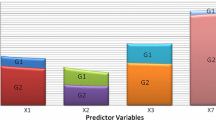Abstract
This study presents an application of linear programming discriminant analysis (LPDA) to classify and to predict the symptomatic status of HIV/AIDS patients. We applied LPDA as well as several traditional discriminant analysis methods to the AIDS Cost and Services Utilization Survey data set in order to demonstrate the use of LPDA to classify the symptomatic status of HIV/AIDS patients. The potential benefit of LPDA in terms of the classification accuracy was also analyzed.
Similar content being viewed by others
REFERENCES
Fisher, R. A., The use of multiple measurements in taxonomy problems. Ann. Eugen. 7:179-188, 1936.
Smith, C. A. B., Some examples of discrimination. Ann. Eugen. 13:272-282, 1947.
Hand, D. J., Discrimination and Classification, Wiley, New York, 1981.
Hand, D. J., Kernel Discriminant Analysis, Research Studies Press, Chichester, NY, 1982.
Kwak, N. K., and Lee, C. W., A neural network application to classification of health status of HIV/AIDS patients. J. Med. Syst. 21(2):87-97, 1997.
Patuwo, E., Hu, M. Y., and Hung, M. S., Two-group classification using neural networks. Decis. Sci. 24(4):825-845, 1993.
Erenguc, S. S., and Koehler, G. J., Survey of mathematical programming models and experimental results for linear discriminant analysis. Manager. Decis. Econ. 11:215-225, 1990.
Joachimsthaler, E. A., and Stam, A., Mathematical programming approaches for the classification problem in two-group discriminant analysis. Multivar. Behav. Res. 25(4):427-454, 1990.
Stam, A., Nontraditional approaches to statistical classification: Some perspectives on LP-norm methods. Ann. Oper. Res. 74:1-36, 1997.
Freed, N., and Glover, F., Simple but powerful goal programming models for discriminant problems. Eur. J. Oper. Res. 7(1):44-60, 1981.
Freed, N., and Glover, F., Applications and implementation: A linear programming approach to the discriminant problem. Decis. Sci. 12(1):68-72, 1981.
Bajgier, S. M., and Hill, A. V., An experimental comparison of statistical and linear programming approaches to the discriminant problem. Decis. Sci. 13(4):604-618, 1982.
Freed, N., and Glover, F., Resolving certain difficulties and improving the classification power of the LP discriminant analysis procedure. Decis. Sci. 17(3):589-595, 1986.
Glover, F., Improved linear programming models for discriminant analysis. Decis. Sci. 21(4):771-785, 1990.
Glover, F., Improved linear and integer programming models for discriminant analysis. In Ijiri, Y. (ed.), Creative and Innovative Approaches to the Science of Management, Quorum Books, Westport, CT, pp. 365-395, 1993.
Glover, F., Keene, S., and Duea, B., A new class of models for the discriminant problem. Decis. Sci. 19(2):269-280, 1988.
Lam, K. F., Choo, E. U., and Moy, J. W., Minimizing deviations from the group mean: A new linear programming approach for the two-group classification problem. Eur. J. Oper. Res. 88(2):358-367, 1996.
Retzlaff-Roberts, D. L., A ratio model for discriminant analysis using linear programming. Eur. J. Oper. Res. 94(1):112-121, 1996.
Robin, P. A., Evaluating the maximize minimum distance formulation of the linear discriminant problem. Eur. J. Oper. Res. 41(2):240-248, 1989.
Silva, P. D., and Stam, A., Second order mathematical programming formulations for discriminant analysis. Eur. J. Oper. Res. 72(1):4-22, 1994.
Stam, A., and Ragsdale, C. T., On the classification gap in mathematical-programming-based approaches to the discriminant problem. Naval Res. Logist. 39(4):545-559, 1992.
Sueyoshi, T., DEA-discriminant analysis in the view of goal programming, Eur. J. Oper. Res. 115:564-582, 1999.
Freed, N., and Glover, F., Evaluating alternative linear programming models to solve the two-group discriminant problem. Decis. Sci. 17(2):151-162, 1986.
Joachimsthaler, E. A., and Stam, A., Four approaches to the classification problem in discriminant analysis: An experimental study. Decis. Sci. 19(2):322-333, 1988.
Lam, K. F., and Moy, J.W., An experimental comparison of some recently developed linear programming approaches to the discriminant problem. Comput. Oper. Res. 24(7):593-599, 1997.
Markowski, C. A., and Markowski, E. P., An experimental comparison of several approaches to the discriminant problem with both qualitative and quantitative variables. Eur. J. Oper. Res. 28(1):74-78, 1987.
Rubin, P. A., A comparison of linear programming and parametric approaches to the two-group discriminant problem. Decis. Sci. 21(2):373-386, 1990.
Retzlaff-Roberts, D., and Puelz, R., Classification in automobile insurance using a DEA and discriminant analysis hybrid. J. Prod. Anal. 7(4):417-427, 1996.
Gordon, K. R., Palmer, M., and Glover, F., Modeling international loan portfolios through linear programming discriminant analysis. J. Pol. Modeling 15(3):297-312, 1993.
Koehler, G. J., Characterization of unacceptable solutions in LP discriminant analysis. Decis. Sci. 20(2):239-257, 1989.
Koehler, G. J., Unacceptable solutions and the hybrid discriminant model. Decis. Sci. 20(4):844-848, 1989.
Koehler, G. J., Improper linear discriminant classifiers. Eur. J. Oper. Res. 50(2):188-198, 1991.
Silva, P. D., and Stam, A., Nonparametric two-group classification: Concepts and a SAS-based software package. Am. Statist. 52(2):185-197, 1998.
Berk, M. L., Maffeo, C., and Schur, C. L., Research design and analysis objectives. AIDS Cost and Services Utilization Survey (ACSUS) Reports No. 1; AHCPR Pub. No. 93-0019, Agency for Health Care Policy and Research, Rockville, MD, (http://www.ahcpr.gov/data/acsus1.htm), 1993.
SAS Institute Inc. SAS/STAT User's Guide, Version 6, 4th edn., Vol. 1, SAS Institute Inc, Cary, NC, 1989.
SAS Institute Inc. SAS/IML Software: Usage and Reference, Version 6, 1st edn., SAS Institute Inc, Cary, NC, 1989.
SAS Institute Inc. SAS/OR User's Guide, Version 6, 1st edn., SAS Institute Inc, Cary, NC, 1989.
Fisher, R. A., The precision of discriminant functions. Ann. Eugen. 10:422-429, 1940.
Lancaster, H. O., Some properties of the bivariate normal distribution considered in the form of a contingency table. Biometrika 44:289-292, 1957.
Overall, J., and Woodward, J. A., Discriminant analysis with categorical data. Appl. Psychol. Meas. 1:371-384, 1977.
Huberty, C. J., Applied Discriminant Analysis, Wiley, New York, 1994.
Author information
Authors and Affiliations
Corresponding author
Rights and permissions
About this article
Cite this article
Kwak, N.K., Kim, S.H., Lee, C.W. et al. An Application of Linear Programming Discriminant Analysis to Classifying and Predicting the Symptomatic Status of HIV/AIDS Patients. Journal of Medical Systems 26, 427–438 (2002). https://doi.org/10.1023/A:1016496916732
Issue Date:
DOI: https://doi.org/10.1023/A:1016496916732




